The Impact of Planting Trees on NOx Concentrations: The Case of the Plaza de la Cruz Neighborhood in Pamplona (Spain)
Abstract
:1. Introduction
2. Description of Study Area, Modelling Set-Up and Investigated Scenarios
2.1. The Study Area and Modeling Set-Up
2.2. Description of Investigated Scenarios
- a)
- The effects of tree-foliage on concentration. LAD = 0.1 and 0.5 m2m−3 have been used to model deciduous vegetation in real cases and evergreen vegetation in virtual cases, respectively;
- b)
- The effects on concentration of introducing new vegetation in a tree-free street.
3. CFD Modelling Evaluation
3.1. Previous Validation Studies
3.2. Current Validation Study
- -
- A deposition velocity of 0.01 m s−1 has been considered, which is a high value for NOx, but still within the range of realistic values [25]. This selection has been done in order to analyze the case where the reduction of concentration by means of vegetation is maximum;
- -
- Three different ranges of inlet wind speeds were considered to simulate the corresponding scenarios for each wind direction, so 48 simulations have been carried out (Table 2);
- -
- Then, depending on wind speed measured by the meteorological station located close to the neighborhood, at each hour the corresponding simulation was selected and the concentrations were computed.
4. Impact of Tree-Foliage on NOx Concentration: Influence of Deposition and Aerodynamic Effects
4.1. The Effects of Deposition
4.2. The Relative Contribution of Aerodynamic and Deposition Effects
5. Impact of New Vegetation on NOx Concentration: Influence of Deposition and Aerodynamic Effects
6. Summary and Conclusions
- -
- The global decrease of concentration at 3 m in the neighborhood due to deposition is small for cases with low LAD (deciduous). For example, in the real-tree case comparing spatial-averaged concentrations from no deposition simulation with simulation considering a deposition velocity of 0.03 m s−1 (very high deposition velocity), differences of less than 2% are observed. A slightly higher effect (6.9%) is obtained for LAD = 0.5 m2m−3; however, deposition effects could be locally higher in certain zones, especially for higher LADs;
- -
- The aerodynamic effects of vegetation induce a general increase of concentration which dominates versus the decreasing of concentration due to deposition. Comparing cases with different LADs, deposition increases with increasing LAD—however spatial-averaged concentrations are always higher for high LADs (dense foliage);
- -
- The inclusion of new trees in one street modifies the distribution of pollutant, not only in that street, but also in nearby locations. Global effects in pollutant concentration are small, however, locally differences much greater of 20 µg m−3 are found when comparing Current cases with New cases. In some zones, the concentration increases with the new trees, but decreases in others. Also, the use of vegetation as an air pollution reduction strategy within the streets seems to not be appropriate in general, and local studies would be necessary for each particular case to select the suitable location of new vegetation planted.
Acknowledgments
Author Contributions
Conflicts of Interest
References
- Gallagher, J.; Baldauf, R.; Fuller, C.H.; Kumar, P.; Gill, L.W.; McNabola, A. Passive methods for improving air quality in the built environment: A review of porous and solid barriers. Atmos. Environ. 2015, 120, 61–70. [Google Scholar] [CrossRef]
- Livesley, S.J.; McPherson, E.G.; Calfapietra, C. The urban forest and ecosystem services: Impacts on urban water, heat, and pollution cycles at the tree, street, and city scale. J. Environ. Qual. 2016, 45, 119–124. [Google Scholar] [CrossRef] [PubMed]
- Grote, R.; Samson, R.; Alonso, R.; Amorim, J.H.; Cariñanos, P.; Churkina, G.; Fares, S.; Le Thiec, D.; Niinemets, Ü.; Mikkelsen, T.N. Functional traits of urban trees in relation to their air pollution mitigation potential: A holistic discussion. Front. Ecol. Environ. 2016, 14, 543–550. [Google Scholar] [CrossRef]
- Mao, Y.; Wilson, J.D.; Kort, J. Effects of a shelterbelt on road dust dispersion. Atmos. Environ. 2013, 79, 590–598. [Google Scholar] [CrossRef]
- Salmond, J.A.; Williams, D.E.; Laing, G.; Kingham, S.; Dirks, K.; Longley, I.; Henshaw, G.S. The influence of vegetation on the horizontal and vertical distribution of pollutants in a street canyon. Sci. Total Environ. 2013, 443, 287–298. [Google Scholar] [CrossRef] [PubMed]
- Jin, S.; Guo, J.; Wheeler, S.; Kan, L.; Che, S. Evaluation of impacts of trees on PM2.5 dispersion in urban streets. Atmos. Environ. 2014, 99, 277–287. [Google Scholar] [CrossRef]
- Chen, X.; Pei, T.; Zhou, Z.; Teng, M.; He, L.; Luo, M.; Liu, X. Efficiency differences of roadside greenbelts with three configurations in removing coarse particles (PM10): A street scale investigation in Wuhan, China. Urban For. Urban Green. 2015, 14, 354–360. [Google Scholar] [CrossRef]
- Mori, J.; Sæbø, A.; Hanslin, H.M.; Teani, A.; Ferrini, F.; Fini, A.; Burchi, G. Deposition of traffic-related air pollutants on leaves of six evergreen shrub species during a Mediterranean summer season. Urban For. Urban Green. 2015, 14, 264–273. [Google Scholar] [CrossRef]
- Tong, Z.; Whitlow, T.H.; MacRae, P.F.; Landers, A.J.; Harada, Y. Quantifying the effect of vegetation on near-road air quality using brief campaigns. Environ. Pollut. 2015, 201, 141–149. [Google Scholar] [CrossRef] [PubMed]
- Di Sabatino, S.; Buccolieri, R.; Pappaccogli, G.; Leo, L.S. The effects of trees on micrometeorology in a real street canyon: Consequences for local air quality. Int. J. Environ. Pollut. 2015, 58, 100–111. [Google Scholar] [CrossRef]
- Chen, L.; Liu, C.; Zou, R.; Yang, M.; Zhan, Z. Experimental examination of effectiveness of vegetation as bio-filter of particulate matters in the urban environment. Environ. Pollut. 2016, 208, 198–208. [Google Scholar] [CrossRef] [PubMed]
- Hofman, J.; Bartholomeus, H.; Janssen, S.; Calders, K.; Wuyts, K.; Van Wittenberghe, S.; Samson, R. Influence of tree crown characteristics on the local PM10 distribution inside an urban street canyon in Antwerp (Belgium): A model and experimental approach. Urban For. Urban Green. 2016, 20, 265–276. [Google Scholar] [CrossRef]
- Tong, Z.; Whitlow, T.H.; Landers, A.; Flanner, B. A case study of air quality above an urban roof top vegetable farm. Environ. Pollut. 2016, 208, 256–260. [Google Scholar] [CrossRef] [PubMed]
- Gromke, C.; Ruck, B. Pollutant Concentrations in Street Canyons of Different Aspect Ratio with Avenues of Trees for Various Wind Directions. Bound.-Layer Meteorol. 2012, 144, 41–64. [Google Scholar] [CrossRef]
- Huang, C.W.; Lin, M.Y.; Khlystov, A.; Katul, G. The effects of leaf area density variation on the particle collection efficiency in the size range of ultrafine particles (UFP). Environ. Sci. Technol. 2013, 47, 11607–11615. [Google Scholar] [CrossRef] [PubMed]
- Räsänen, J.V.; Holopainen, T.; Joutsensaari, J.; Ndam, C.; Pasanen, P.; Rinnan, A.; Kivimäenpää, M. Effects of species-specific leaf characteristics and reduced water availability on fine particle capture efficiency of trees. Environ. Pollut. 2013, 183, 64–70. [Google Scholar] [CrossRef] [PubMed]
- Gromke, C.; Jamarkattel, N.; Ruck, B. Influence of roadside hedgerows on air quality in urban street canyons. Atmos. Environ. 2016, 139, 75–86. [Google Scholar] [CrossRef]
- Janhäll, S. Review on urban vegetation and particle air pollution—Deposition and dispersion. Atmos. Environ. 2015, 105, 130–137. [Google Scholar] [CrossRef]
- Salmond, J.A.; Tadaki, M.; Vardoulakis, S.; Arbuthnott, K.; Coutts, A.; Demuzere, M.; Dirks, K.N.; Heaviside, C.; Lim, S.; Macintyre, H.; et al. Health and climate related ecosystem services provided by street trees in the urban environment. Environ. Health. 2016, 15 (Suppl. 1), 36. [Google Scholar] [CrossRef] [PubMed] [Green Version]
- Abhijith, K.V.; Kumar, P.; Gallagher, J.; McNabola, A.; Baldauf, R.; Pilla, F.; Broderick, B.; Di Sabatino, S.; Pulvirenti, B. Air pollution abatement performances of green infrastructure in open road and built-up street canyon environments—A review. Atmos. Environ. 2017, 162, 71–86. [Google Scholar] [CrossRef]
- Buccolieri, R.; Salim, S.M.; Leo, L.S.; Di Sabatino, S.; Chan, A.; Ielpo, P.; Gromke, C. Analysis of local scale tree–atmosphere interaction on pollutant concentration in idealized street canyons and application to a real urban junction. Atmos. Environ. 2011, 45, 1702–1713. [Google Scholar] [CrossRef]
- Wania, A.; Bruse, M.; Blond, N.; Weber, C. Analysing the influence of different street vegetation on traffic-induced particle dispersion using microscale simulations. J. Environ. Manag. 2012, 94, 91–101. [Google Scholar] [CrossRef] [PubMed]
- Amorim, J.H.; Rodrigues, V.; Tavares, R.; Valente, J.; Borrego, C. CFD modelling of the aerodynamic effect of trees on urban air pollution dispersion. Sci. Total Environ. 2013, 461, 541–551. [Google Scholar] [CrossRef] [PubMed]
- Santiago, J.L.; Martín, F.; Martilli, A. A computational fluid dynamic modelling approach to assess the representativeness of urban monitoring stations. Sci. Total Environ. 2013, 454–455, 61–72. [Google Scholar] [CrossRef] [PubMed]
- Gromke, C.; Blocken, B. Influence of avenue-trees on air quality at the urban neighborhood scale. Part II: Traffic pollutant concentrations at pedestrian level. Environ. Pollut. 2015, 196, 176–184. [Google Scholar] [CrossRef] [PubMed]
- Jeanjean, A.P.R.; Monks, P.S.; Leigh, R.J. Modelling the effectiveness of urban trees and grass on PM2.5 reduction via dispersion and deposition at a city scale. Atmos. Environ. 2016, 147, 1–10. [Google Scholar] [CrossRef]
- Jeanjean, A.; Buccolieri, R.; Eddy, J.; Monks, P.; Leigh, R. Air quality affected by trees in real street canyons: The case of Marylebone neighbourhood in central London. Urban For. Urban Green. 2017, 22, 41–53. [Google Scholar] [CrossRef]
- Santiago, J.-L.; Martilli, A.; Martin, F. On Dry Deposition Modelling of Atmospheric Pollutants on Vegetation at the Microscale: Application to the Impact of Street Vegetation on Air Quality. Bound.-Layer Meteorol. 2017, 162, 451–474. [Google Scholar] [CrossRef]
- Selmi, W.; Weber, C.; Rivière, E.; Blond, N.; Mehdi, L.; Nowak, D. Air pollution removal by trees in public green spaces in Strasbourg city, France. Urban For. Urban Green. 2016, 17, 192–201. [Google Scholar] [CrossRef]
- Tong, Z.; Baldauf, R.W.; Isakov, V.; Deshmukh, P.; Max Zhang, K. Roadside vegetation barrier designs to mitigate near-road air pollution impacts. Sci. Total Environ. 2016, 541, 920–927. [Google Scholar] [CrossRef] [PubMed]
- Vos, P.E.; Maiheu, B.; Vankerkom, J.; Janssen, S. Improving local air quality in cities: To tree or not to tree? Environ. Pollut. 2013, 183, 113–122. [Google Scholar] [CrossRef] [PubMed]
- Haaland, C.; van den Bosch, C.K. Challenges and strategies for urban green-space planning in cities undergoing densification: A review. Urban For. Urban Green. 2015, 14, 760–771. [Google Scholar] [CrossRef]
- Google Maps®. Available online: https://www.google.es/maps (accessed on 4 May 2017).
- CD-adapco. User Guide STAR-CCM+ Version 7.04. Cd-adapco, 2012. Available online: http://www.cd-adapco.com/products/star-ccm%C2%AE (accessed on 21 July 2017).
- Sanchez, B.; Santiago, J.L.; Martilli, A.; Palacios, M.; Kirchner, F. CFD modeling of reactive pollutant dispersion in simplified urban configurations with different chemical mechanisms. Atmos. Chem. Phys. 2016, 16, 12143–12157. [Google Scholar] [CrossRef]
- Sanchez, B.; Santiago, J.L.; Martilli, A.; Martin, F.; Borge, R.; Quaassdorff, C.; de la Paz, D. Modelling NOx concentrations through CFD-RANS in an urban hot-spot using high resolution traffic emissions and meteorology from a mesoscale model. Atmos. Environ. 2017, 163, 155–165. [Google Scholar] [CrossRef]
- Krayenhoff, E.S.; Santiago, J.L.; Martilli, A.; Christen, A.; Oke, T.R. Parametrization of drag and turbulence for urban neighbourhoods with trees. Bound.-Layer Meteor. 2015, 156, 157–189. [Google Scholar] [CrossRef]
- Sanz, C. A note on k−ε modeling of vegetation canopy air-flows. Bound.-Layer Meteor. 2003, 108, 191–197. [Google Scholar] [CrossRef]
- Google Earth®. Available online: https://www.google.com/intl/es/earth/ (accessed on 4 May 2017).
- Franke, J.; Schlünzen, H.; Carissimo, B. Best Practice Guideline for the CFD Simulation of Flows in the Urban Environment. COST Action 732—Quality assurance and improvement of microscale meteorological models; Distributed by University of Hamburg (Germany), Meteorological Institute: Hamburg, Germany, 2007; ISBN 3-00-018312-4. [Google Scholar]
- Richards, P.; Hoxey, R. Appropriate boundary conditions for computational wind engineering models using the k-turbulence model. J. Wind Eng. Ind. Aerodyn. 1993, 46, 145–153. [Google Scholar] [CrossRef]
- Santiago, J.L.; Borge, R.; Martin, F.; de la Paz, D.; Martilli, A.; Lumbreras, J.; Sanchez, B. Evaluation of a CFD-based approach to estimate pollutant distribution within a real urban canopy by means of passive samplers. Sci. Total Environ. 2017, 576, 46–58. [Google Scholar] [CrossRef] [PubMed]
- Rivas, E.; Santiago, J.L.; Martin, F.; Sánchez, B.; Martilli, A. CFD study of induced effects of trees on air quality in a neighborhood of Pamplona. 10th International Conference on Air Quality—Science and Application, Milan, Italy, 14–18 March 2016; Available online: https://drive.google.com/drive/folders/0B2iFZ3L-H5pRazh6QjlBWGVWcHc (accessed on 3 March 2017).
- Lalic, B.; Mihailovic, D.T. An empirical relation describing leaf-area density inside the forest for environmental modeling. J. Appl. Meteor. 2004, 43, 641–645. [Google Scholar] [CrossRef]
- Brunet, Y.; Finnigan, J.J.; Raupach, M.R. A wind tunnel study of air flow in waving wheat: Single-point velocity statistics. Bound.-Layer Meteor. 1994, 70, 95–132. [Google Scholar] [CrossRef]
- Raupach, M.R.; Bradley, E.F.; Ghadiri, H. Wind Tunnel Investigation Into the Aerodynamic Effect of Forest Clearing on the Nesting of Abbott’s Booby on Christmas Island; Internal report; CSIRO Centre for Environmental Mechanics: Canberra, Australia, 1987. [Google Scholar]
- Foudhil, H.; Brunet, Y.; Caltagirone, J.P. A Fine-Scale k−ε Model for Atmospheric Flow over Heterogeneous Landscapes. Environ. Fluid Mech. 2005, 5, 247–265. [Google Scholar] [CrossRef]
- Dupont, S.; Brunet, Y. Edge flow and canopy structure: A large-eddy simulation study. Bound.-Layer Meteor. 2008, 126, 51–71. [Google Scholar] [CrossRef]
- Gromke, C.; Ruck, B. Influence of trees on the dispersion of pollutants in an urban street canyon-experimental investigation of the flow and concentration field. Atmos. Environ. 2007, 41, 3287–3302. [Google Scholar] [CrossRef]
- Gromke, C.; Ruck, B. On the impact of trees on dispersion processes of traffic emissions in street canyons. Bound.-Layer Meteor. 2009, 131, 19–34. [Google Scholar] [CrossRef]
- Gromke, C.; Buccolieri, R.; Di Sabatino, S.; Ruck, B. Dispersion study in a street canyon with tree planting by means of wind tunnel and numerical investigations—Evaluation of CFD data with experimental data. Atmos. Environ. 2008, 42, 8640–8650. [Google Scholar] [CrossRef]
- Balczó, M.; Gromke, C.; Ruck, B. Numerical modeling of flow and pollutant dispersion in street canyons with tree planting. Meteorologische. Zeitschrift. 2009, 18, 197–206. [Google Scholar] [CrossRef]
- Vranckx, S.; Vos, P.; Maiheu, B.; Janssen, S. Impact of trees on pollutant dispersion in street canyons: A numerical study of the annual average effects in Antwerp, Belgium. Sci. Total Environ. 2015, 532, 474–483. [Google Scholar] [CrossRef] [PubMed]
- Moonen, P.; Gromke, C.; Dorer, V. Performance assessment of large eddy simulation (LES) for modelling dispersion in an urban street canyon with tree planting. Atmos. Environ. 2013, 75, 66–76. [Google Scholar] [CrossRef]
- Buccolieri, R.; Gromke, C.; Di Sabatino, S.; Ruck, B. Aerodynamic effects of trees on pollutant concentration in street canyon. Sci. Total Environ. 2009, 407, 5247–5256. [Google Scholar] [CrossRef] [PubMed]

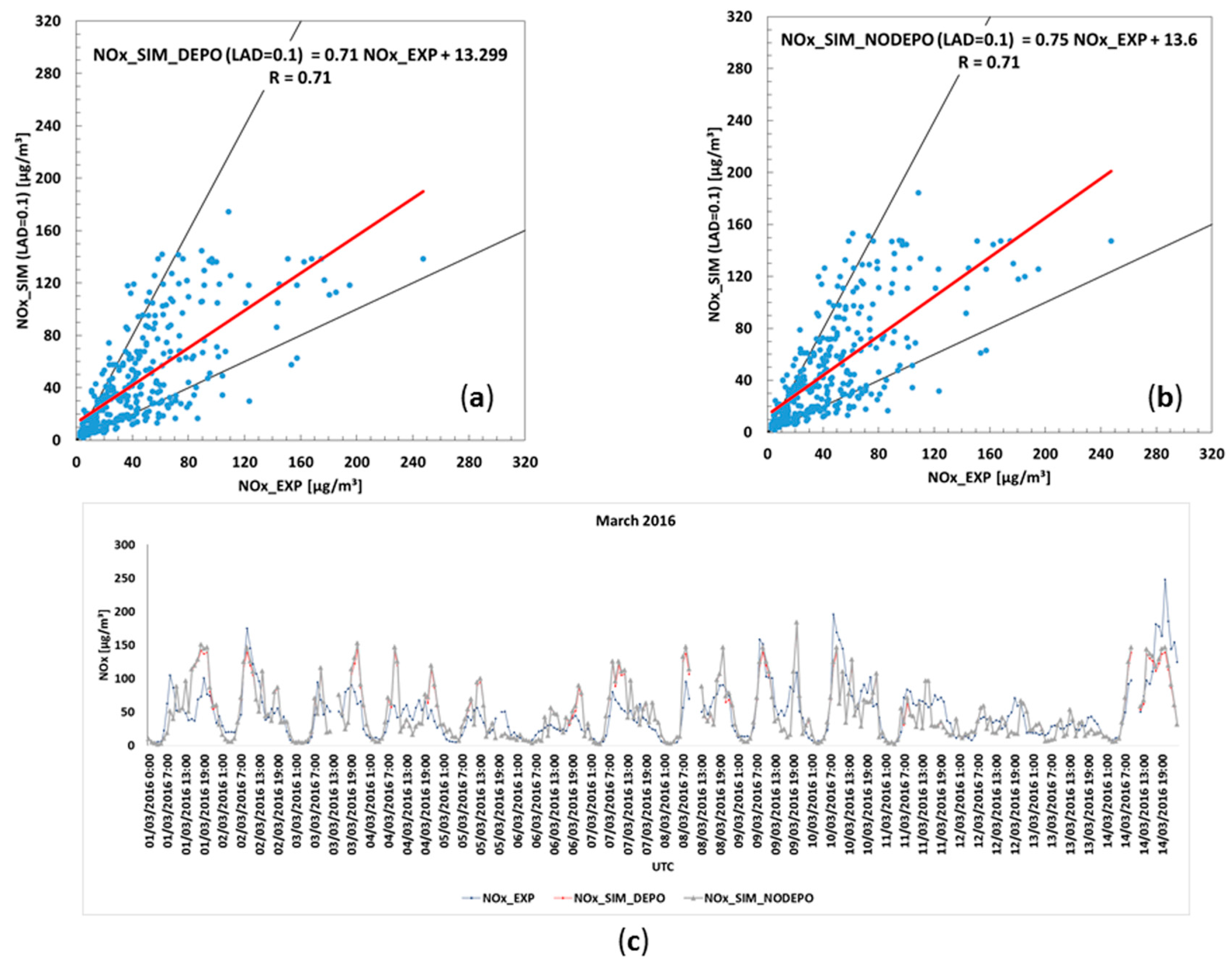
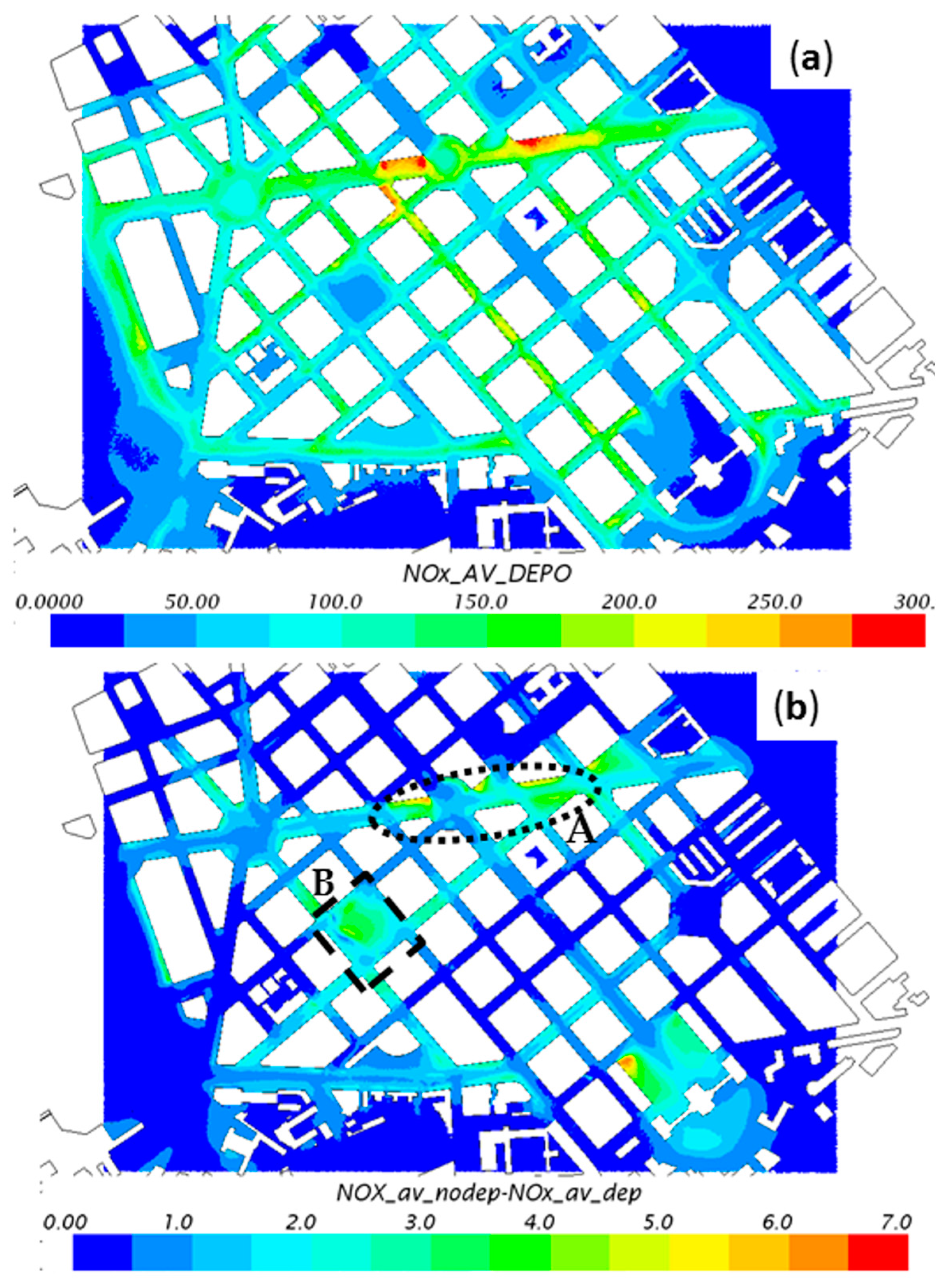
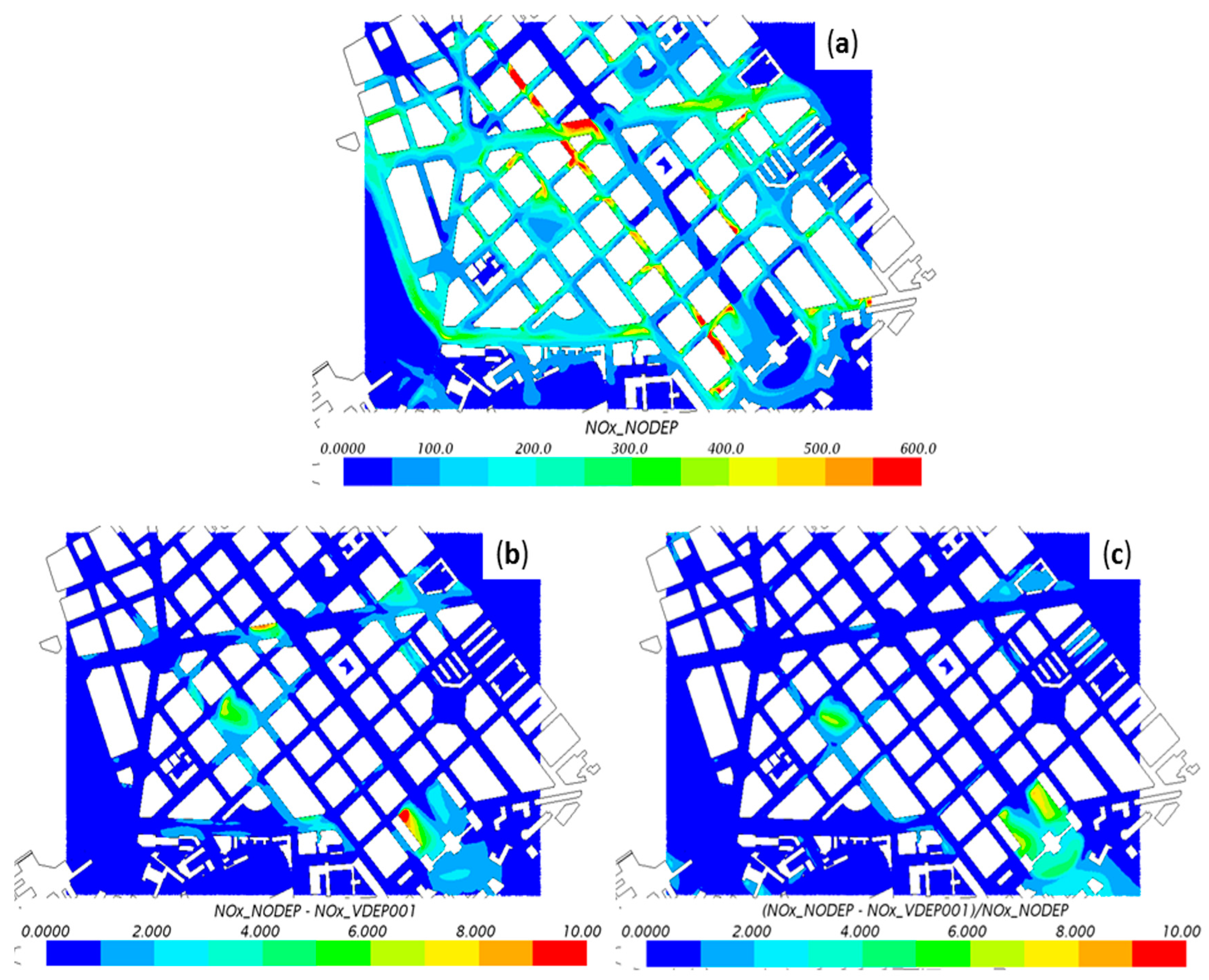



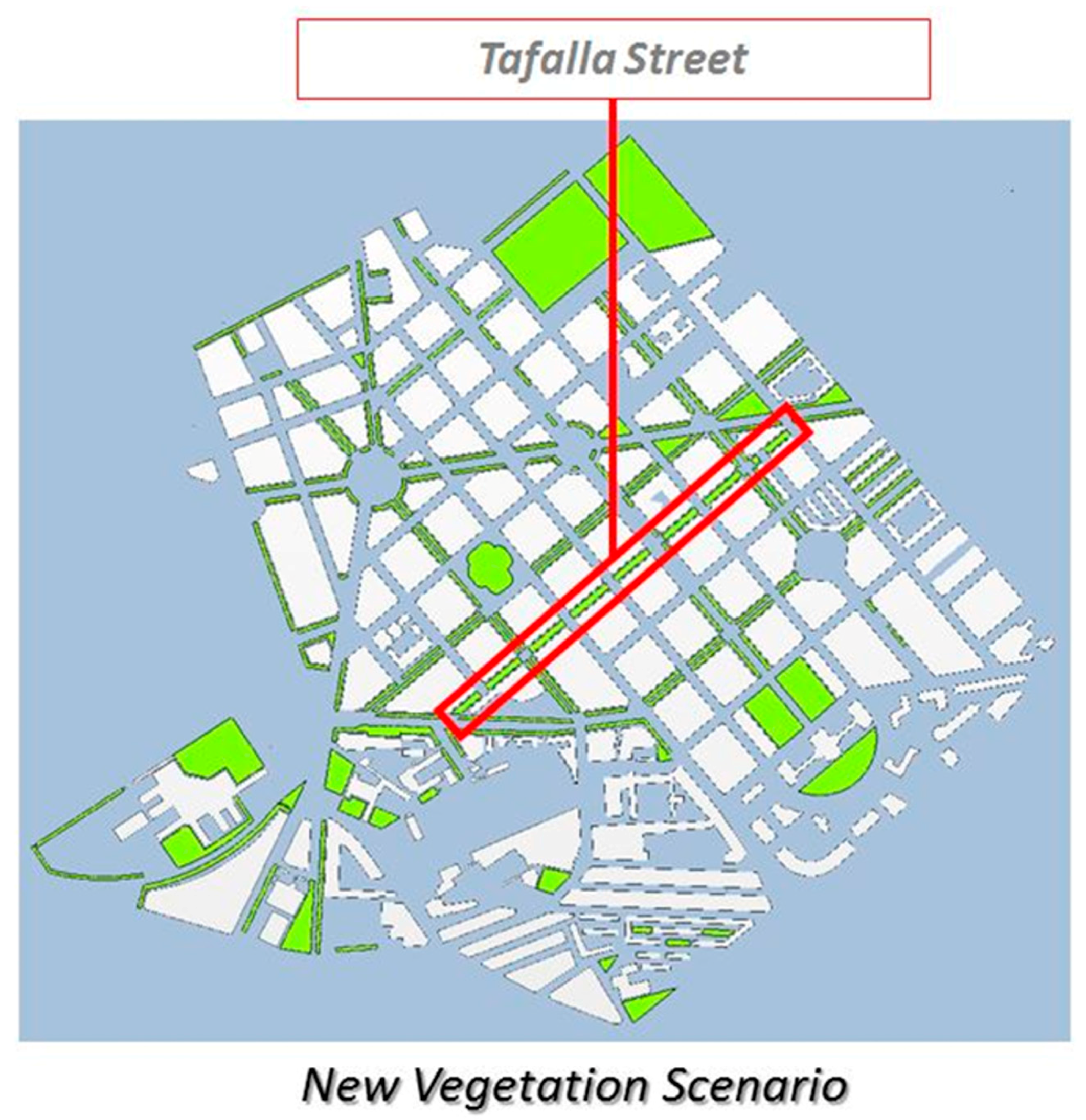
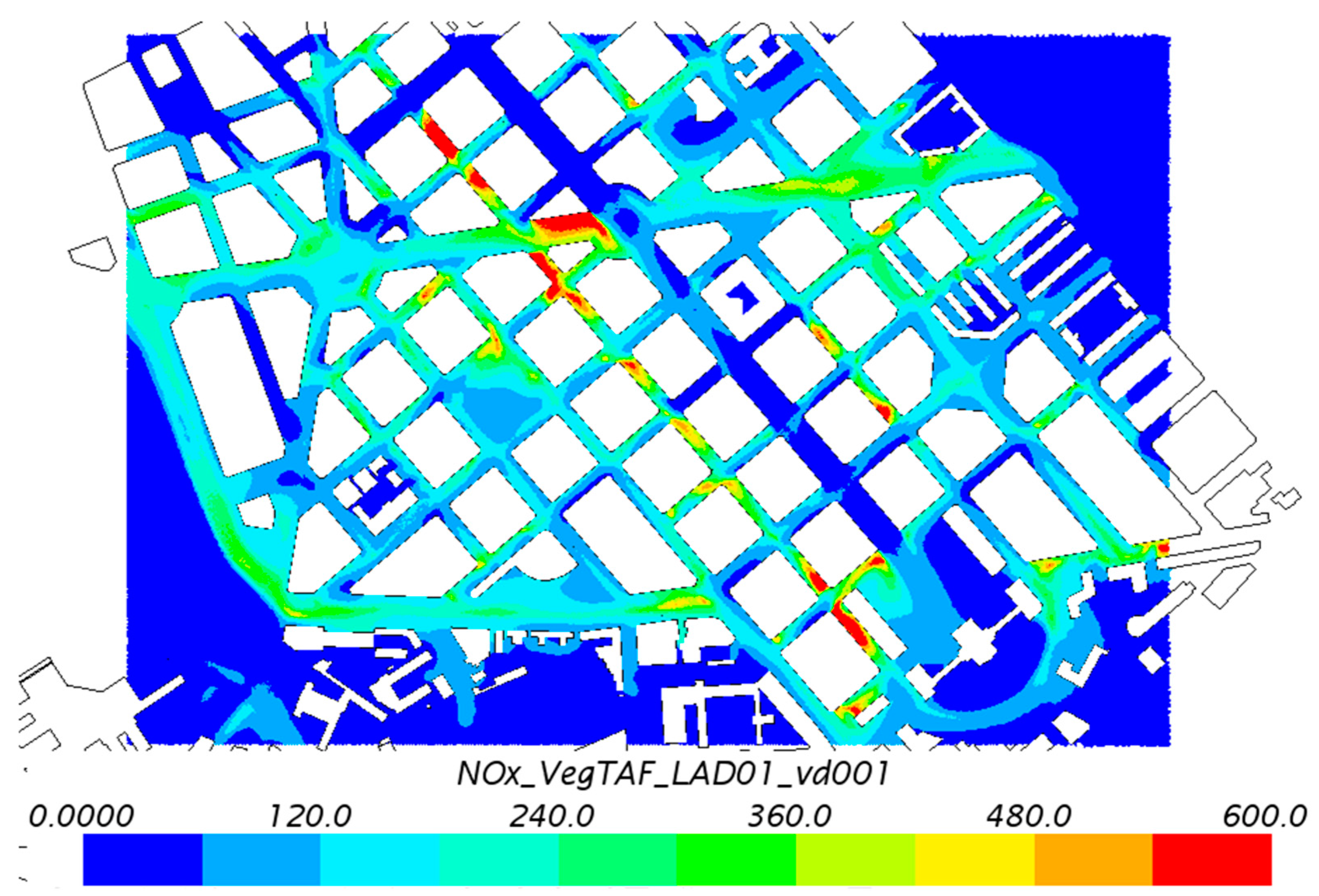
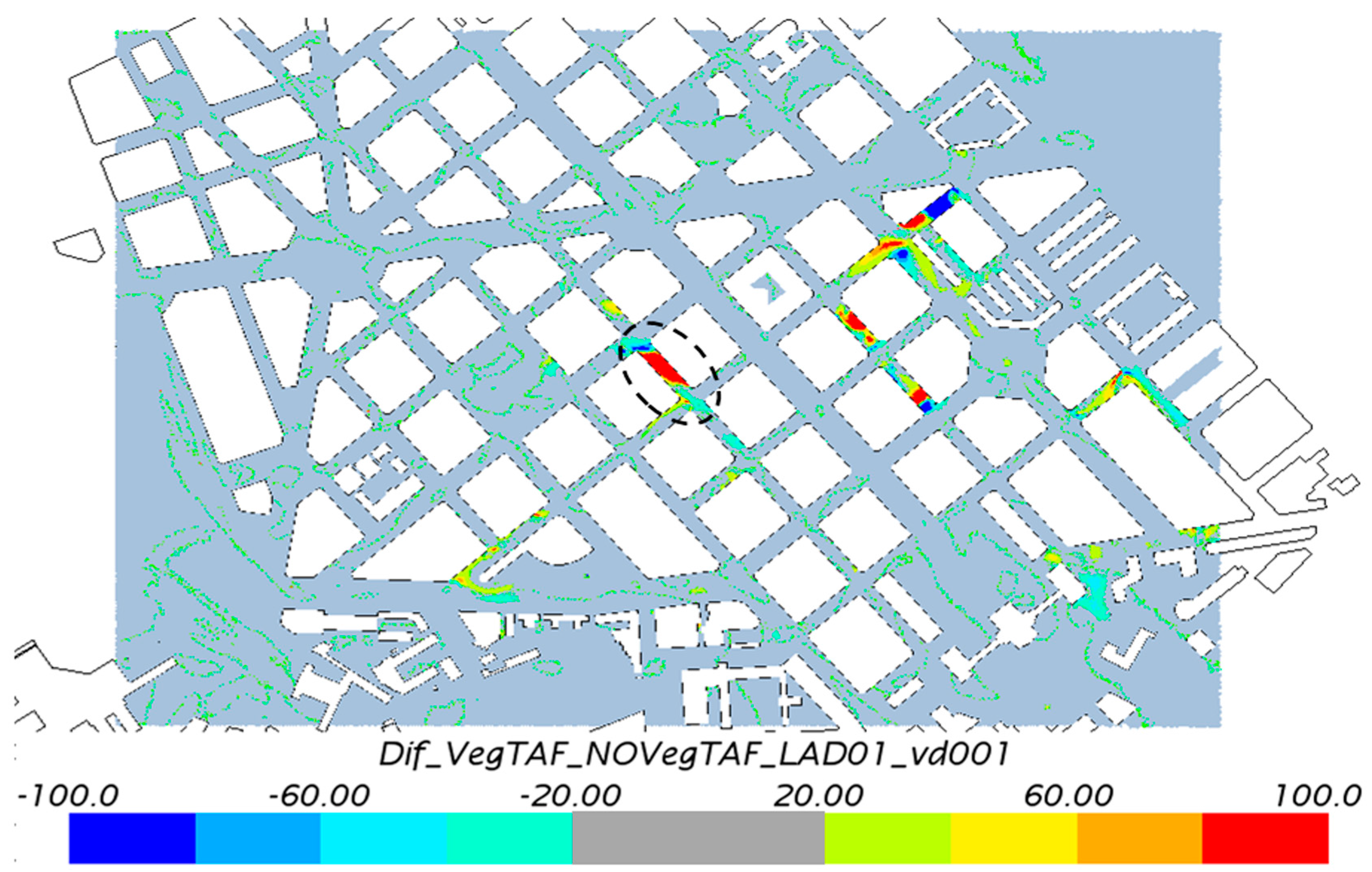

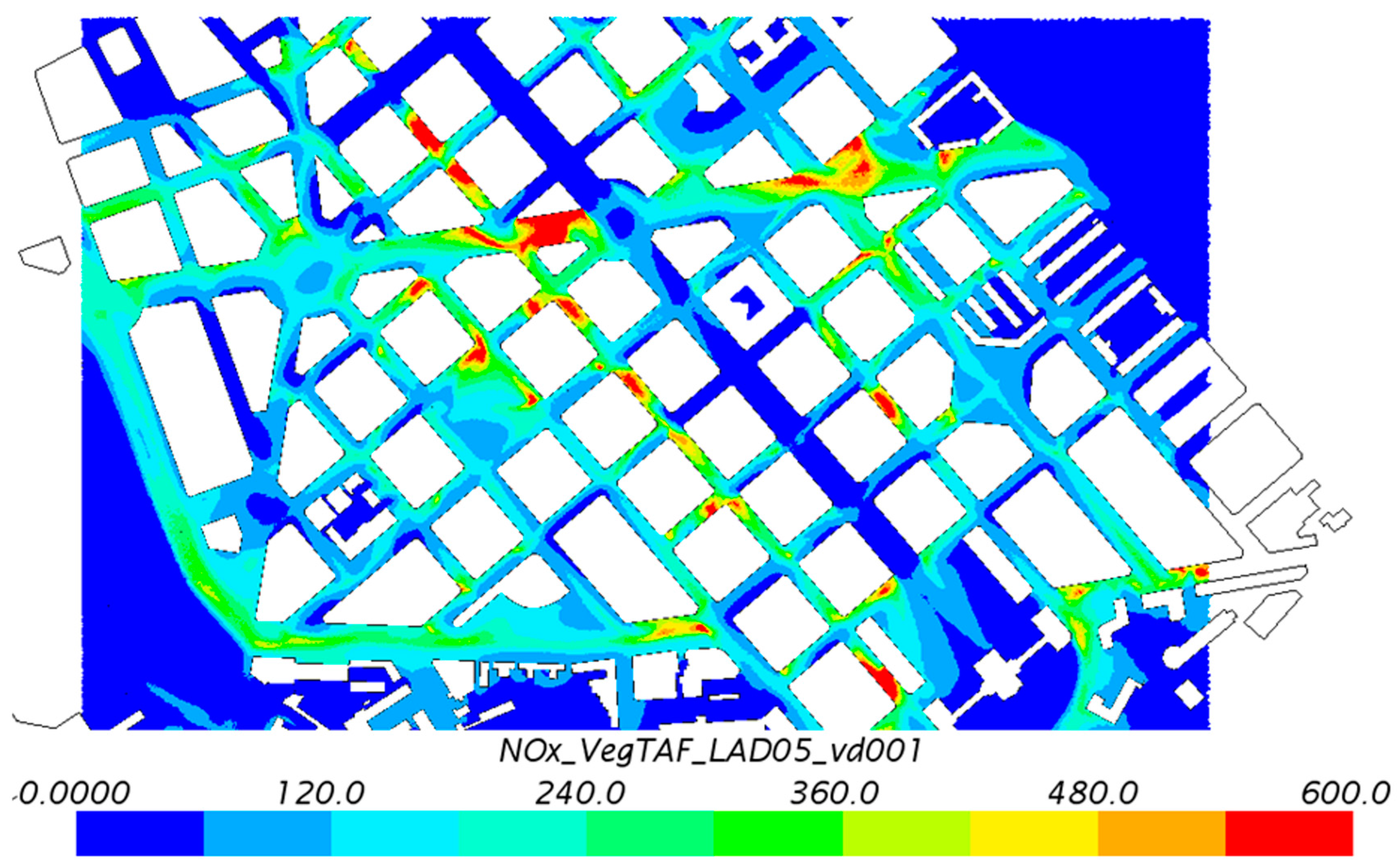


| Scenario | Location of Vegetation | Type of Vegetation | Deposition Velocity (m s−1) |
|---|---|---|---|
| Current-1.a | Current location | Deciduous (LAD = 0.1 m2m−3) | 0 |
| Current-1.b | 0.005 | ||
| Current-1.c | 0.01 | ||
| Current-1.d | 0.03 | ||
| Current-2.a | Current location | Evergreen (LAD = 0.5 m2m−3) | 0 |
| Current-2.b | 0.005 | ||
| Current-2.c | 0.01 | ||
| Current-2.d | 0.03 | ||
| New-1.a | New trees in one tree-free street | Deciduous (LAD = 0.1 m2m−3) | 0 |
| New-1.b | 0.005 | ||
| New-1.c | 0.01 | ||
| New-1.d | 0.03 | ||
| New-2.a | New trees in one tree-free street | Evergreen (LAD = 0.5 m2m−3) | 0 |
| New-2.b | 0.005 | ||
| New-2.c | 0.01 | ||
| New-2.d | 0.03 |
| Ranges of Inlet Wind Speed at 10 m | vref/vdep |
|---|---|
| vref > 4.5 m·s−1 | 640 |
| 2 m·s−1 < vref < 4.5 m·s−1 | 320 |
| vref < 2 m·s−1 | 107 |
| Deposition Velocity | Maximum of Reduction (µg m−3) | Maximum of Relative Reduction | Reduction Zone 1 (%) | Reduction Zone 2 (%) | Spatial-Averaged Concentration (µg m−3) | Reduction of Spatial-Averaged Concentration (%) |
|---|---|---|---|---|---|---|
| 0.005 | 6.9 | 4.5 | 0.07 | 0 | 105.0 | 0.27 |
| 0.01 | 13.4 | 8.7 | 0.9 | 0.7 | 104.7 | 0.54 |
| 0.03 | 35.6 | 25 | 7 | 4 | 103.7 | 1.54 |
| Deposition Velocity | Maximum of Reduction (µg m−3) | Maximum of Relative Reduction | Reduction Zone 1 (%) | Reduction Zone 2 (%) | Spatial-Averaged Concentration (µg m−3) | Reduction of Spatial-Averaged Concentration (%) |
|---|---|---|---|---|---|---|
| 0.005 | 38 | 31 | 8 | 3.6 | 111.2 | 1.5 |
| 0.01 | 66 | 49 | 17 | 9.2 | 109.7 | 2.8 |
| 0.03 | 147 | 74 | 40 | 30.5 | 105.1 | 6.9 |
© 2017 by the authors. Licensee MDPI, Basel, Switzerland. This article is an open access article distributed under the terms and conditions of the Creative Commons Attribution (CC BY) license (http://creativecommons.org/licenses/by/4.0/).
Share and Cite
Santiago, J.-L.; Rivas, E.; Sanchez, B.; Buccolieri, R.; Martin, F. The Impact of Planting Trees on NOx Concentrations: The Case of the Plaza de la Cruz Neighborhood in Pamplona (Spain). Atmosphere 2017, 8, 131. https://doi.org/10.3390/atmos8070131
Santiago J-L, Rivas E, Sanchez B, Buccolieri R, Martin F. The Impact of Planting Trees on NOx Concentrations: The Case of the Plaza de la Cruz Neighborhood in Pamplona (Spain). Atmosphere. 2017; 8(7):131. https://doi.org/10.3390/atmos8070131
Chicago/Turabian StyleSantiago, Jose-Luis, Esther Rivas, Beatriz Sanchez, Riccardo Buccolieri, and Fernando Martin. 2017. "The Impact of Planting Trees on NOx Concentrations: The Case of the Plaza de la Cruz Neighborhood in Pamplona (Spain)" Atmosphere 8, no. 7: 131. https://doi.org/10.3390/atmos8070131






